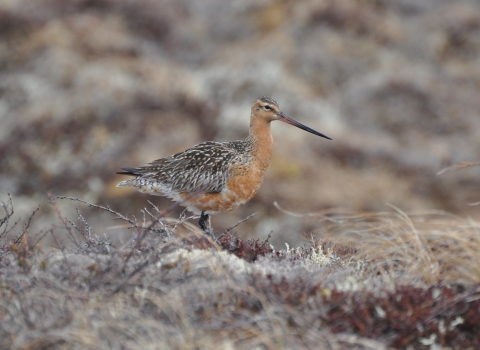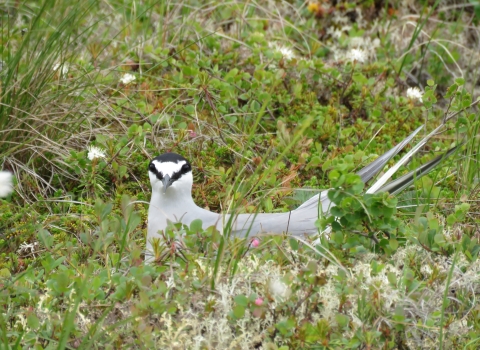Projects and Research
Our research and monitoring efforts span the state of Alaska. From tundra lakes on the Arctic coastal plain to wetlands in the boreal forest, our staff are involved in a number of projects and conservation efforts for many species of migratory birds. Learn more about what we do through our project, stories, and publications.
Shorebirds are quickly declining in North America. To better understand what's affecting shorebird populations, in 2003 we established a long-term study of the breeding ecology of shorebirds at Utqiaġvik (formerly Barrow), Alaska. Each year, a group of biologists, volunteers, and students work in the tundra surrounding Utqiaġvik finding hundreds of nests, banding hundreds of...
The Alaska-breeding Bar-tailed Godwit (Limosa lapponica baueri), a shorebird known as Cugerpak in Yup’ik and Kūaka in Māori, has experienced significant population declines. The main reason for these declines is believed to be the loss of feeding grounds in the Yellow Sea, where they stop to rest and eat during their spring migration. However, other factors on their Alaska...
Working together with Manomet, Inc., the U.S. Geological Survey, Bureau of Land Management, Alaska Fish and Game Department, and others, we conduct extensive shorebird surveys throughout Alaska as part of the Program for Regional and International Shorebird Monitoring (PRISM). This work was initiated in 1998 and has included most of the Arctic Coastal Plain and the Yukon Delta...
The roselaari Red Knot population is one of North America’s rarest shorebird populations (Lyons et al. 2015). It is listed as endangered in Mexico and threatened in Canada. In the United States, the roselaari Red Knot have shown declines in their breeding and migration areas (Tomkovich and Dondua 2008, Buchanan et al. 2010), but the subspecies was denied threatened status by the USFWS...
The breeding season of migratory shorebirds’ life is just one piece to the conservation puzzle. What happens during a species’ migration and on their wintering grounds can affect their ability to survive and reproduce on their breeding grounds. However, we still need to better understand how shorebirds migrate, where and when they stop for rest, and generally how populations interact...
If you have spent time in the summer along the coastline of Alaska, chances are you’ve encountered a tern. Terns are graceful, pale grey seabirds that float between land and water, hovering and diving for small fish. Tern species in Alaska have long narrow wings, forked tails, and black caps.
Take a closer...
Kittlitz’s Murrelet, Marbled Murrelet, and Pigeon Guillemot are marine bird species that were especially affected by the 1989 Exxon Valdez Oil Spill (EVOS). Estimates suggest that 5-10% of Kittlitz’s Murrelet and 6-12% of Marbled Murrelet populations in the spill zone were killed due to oil exposure. Since, surveys have shown that Kittlitz’s Murrelet populations have declined by 75-90...
Alaska provides critical habitat for marine birds, with Alaska's coasts and offshore waters supporting some of the largest marine bird breeding populations in the world. Each summer, around 30 million marine birds breed along Alaska's extensive coastline, which stretches for 46,000 miles, while another 30 million migrate to these productive waters, drawn by the abundance of food....
Prince William Sound (PWS) in Alaska provides important feeding, resting, and breeding sites for many marine birds and mammals. When the T/V Exxon Valdez ran aground in PWS in 1989 and spilled 40 million liters of crude oil into the surrounding waters, 250,000 birds died as a direct result. In the years that followed, it became challenging to understand the full impact of the oil spill...
Since 2005, the U.S. Fish and Wildlife Service has partnered with the National Park Service to conduct surveys for yellow-billed loons in the Bering Land Bridge National Preserve and Cape Krusenstern National Monument located in the northwest Arctic of Alaska. Yellow-billed loons are a species of conservation concern due to their small global population and habitat limitations, and are...
This video series was created and produced by young professionals and focuses on the rare, yellow-billed loon and the collaborative research that is helping scientists understand and conserve this iconic species in the face of environmental change. How will loons adapt? What can you do to help? We welcome you to watch these videos to find out more.
Yellow...
The Arctic Coastal Plain (ACP) is a vast area of Arctic lowland tundra in far northern Alaska that serves as an important region for many species of breeding birds, especially waterbirds. Importantly, it is the only regularly used breeding area in North America for threatened Steller’s eiders (Polysticta stelleri), and one of only three breeding areas for the threatened Spectacled eider (...
The Fall Pacific Black Brant Photo Survey is a project aimed at monitoring the population of the Pacific Black Brant population (Branta bernicla nigricans) during their fall staging period at Izembek Lagoon in Alaska. Traditionally, estimates of geese and other waterfowl at Izembek National Wildlife Refuge relied on the eyes of biologists flying in small airplanes. However, we have now...
Dusky Canada Geese (Branta canadensis occidentalis) comprise one of the smallest populations of geese in North America. The primary nesting area for dusky Canada Geese is the Cooper River Delta, near Cordova, Alaska, and a smaller population on Middleton Island in the Gulf of Alaska. The famous Great Alaskan Earthquake (or Good Friday Earthquake) of 1964 altered the Copper River Delta...
Mallard banding in Alaska is one component in setting hunting regulations for the species along the Pacific Flyway. Western mallards of the Pacific Flyway consist of birds that breed in Alaska, or those that breed in the southern Pacific Flyway (California, Oregon, Washington, and British Columbia). The current banding goals for mallards in Alaska is 1,000 adult males, 1,000 adult...
The mid-continent population of greater white-fronted geese (Anser albifrons frontalis) breeds in tundra habitats from the eastern shore of Hudson Bay to the west coast of northern Alaska, south into boreal forests and taiga habitat in interior and northwest Alaska. The winter range extends through Central and Mississippi Flyway states and into portions of Mexico. Throughout its range,...
The Waterfowl Breeding Population and Habitat Survey (WBPHS) has been conducted annually since 1955 (1957 in Alaska) by the U.S. Fish and Wildlife Service (FWS) and Canadian Wildlife Service to estimate the spring abundance of dabbling ducks and other waterfowl of management concern in their principal breeding areas of North America. The survey is continental in scope requiring numerous...
Every year since 1981, the U.S., Canada, and Mexico work together to count Pacific black brant (Branta bernicla nigricans) along their Pacific Coast wintering areas in Baja, Mexico, California, Oregon, Washington, British Columbia, and Alaska. This survey, known as the Pacific Flyway Brant Survey, happens every year between January-February and involves coordinated teams counting birds...
The Yukon-Kuskokwim Delta Aerial Breeding Pair Survey provides data on the abundance and distribution of geese and eiders nesting on the YKD coastal zone in western Alaska. Wetland habitat in this region supports millions of waterbirds and is one of the most important waterfowl breeding grounds in North America. The survey was first implemented in 1985 to monitor populations of minima cackling...
Sea ducks are a large group of waterfowl that, relative to other waterfowl, we know little about. The Sea Duck Joint Venture (SDJV) was formed to learn more about sea ducks, make information available to stakeholders, and ensure sustainable populations over the long term.
About the Sea Duck Joint VentureThe vision of the SDJV is to maintain sustainable populations of North...
The Alaska Landbird Monitoring Survey (ALMS) is a collaborative survey developed by the U.S. Geological Survey and implemented by various federal, state, and non-governmental organizations throughout the state of Alaska. This program, established in 2003 and continuing today, contributes to analyses of population trends at regional and continental levels and models changes in bird distribution...
The McKay's Bunting, a small songbird found only on the remote St. Matthew and Hall Islands in the Bering Sea, is facing a critical situation. Its population has been steadily declining, raising concerns about its future. Recent surveys from St. Matthew and Hall Island found the global population declined 38% from 2003 to 2018, equivalent to -3.2% loss per year. The decline is likely...
American Goshawks are one of North America’s most elusive birds of prey. Goshawk ecology has been studied thoroughly across many parts of their range, but little is understood about their ecology and life history in the Alaska. On Joint Base Elmendorf-Richardson (JBER), located north of Anchorage, there have been preliminary surveys for American goshawk nests in recent years but there...
The conservation of migratory birds requires identifying how events across their annual cycle (often occurring across vast areas) influence their survival and reproduction. It is thought that most golden eagles in Alaska are migratory and move south during autumn to over-winter in the western contiguous U.S. Thus, factors that may affect the golden eagle population in Alaska (e.g., energy...
Using the Utqiaġvik site as a stepping stone, the Shorebird Section of Migratory Bird Management co-created the Arctic Shorebird Demographics Network (ASDN) with Dr. Stephen Brown of Manomet, Inc. and Dr. Brett Sandercock of Kansas State University in 2010. The ASDN included collaborations by 33 principal investigators and >10 graduate students from 21 institutions across 16 field...


























